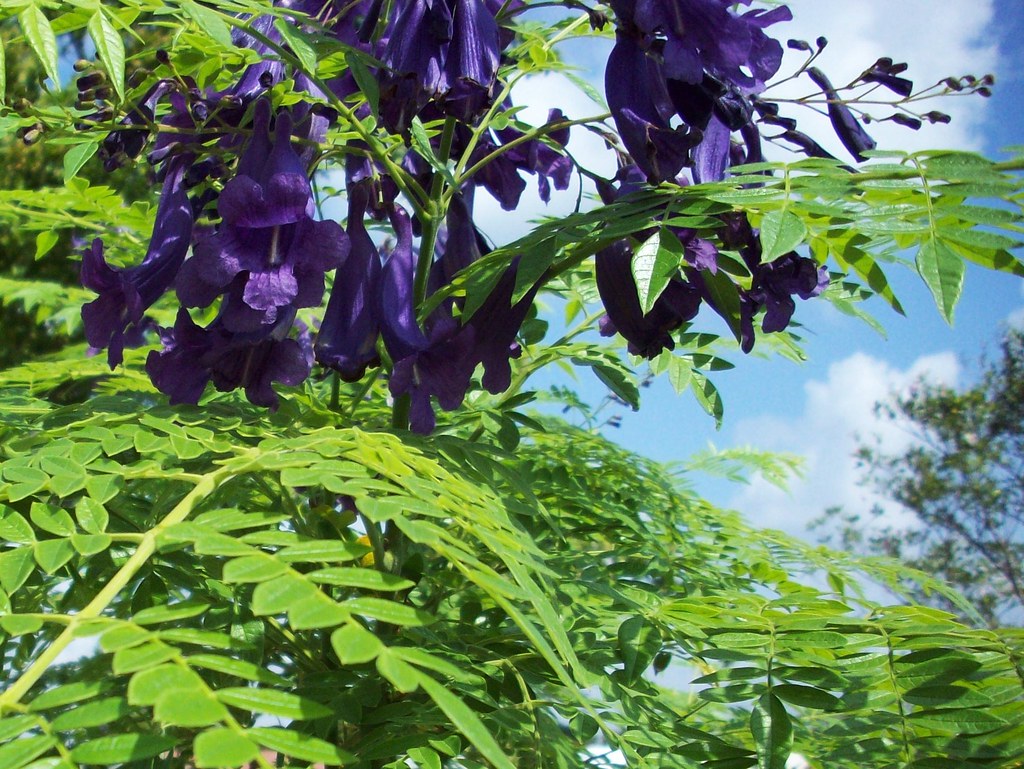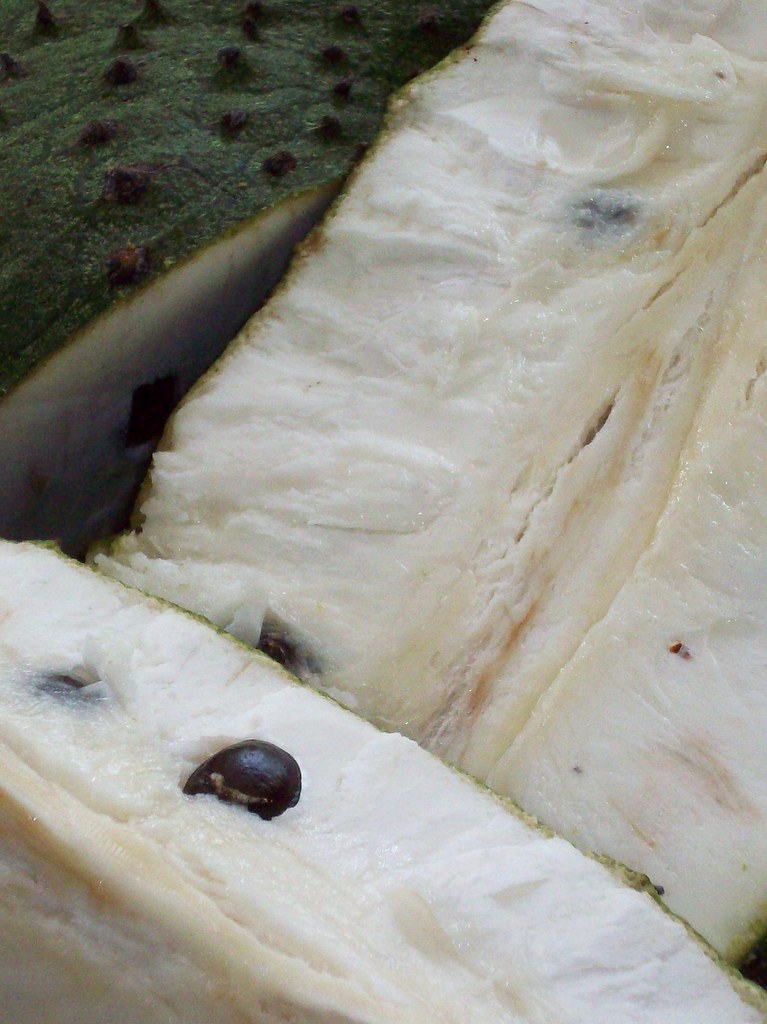Cherry of the Rio Grande


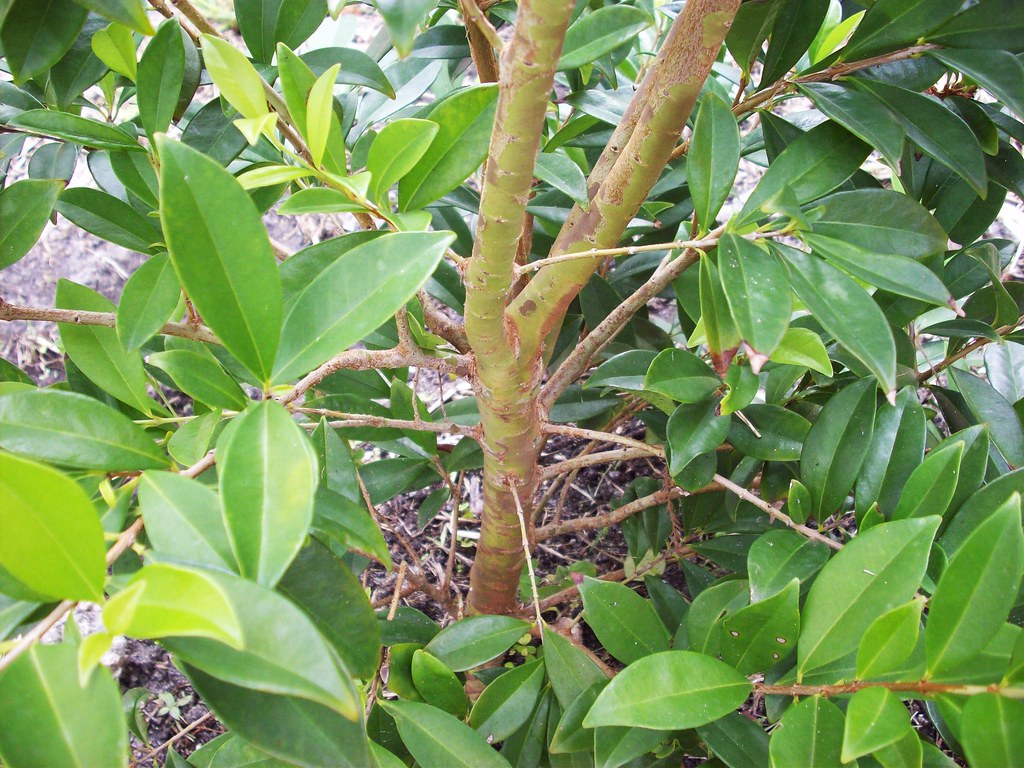
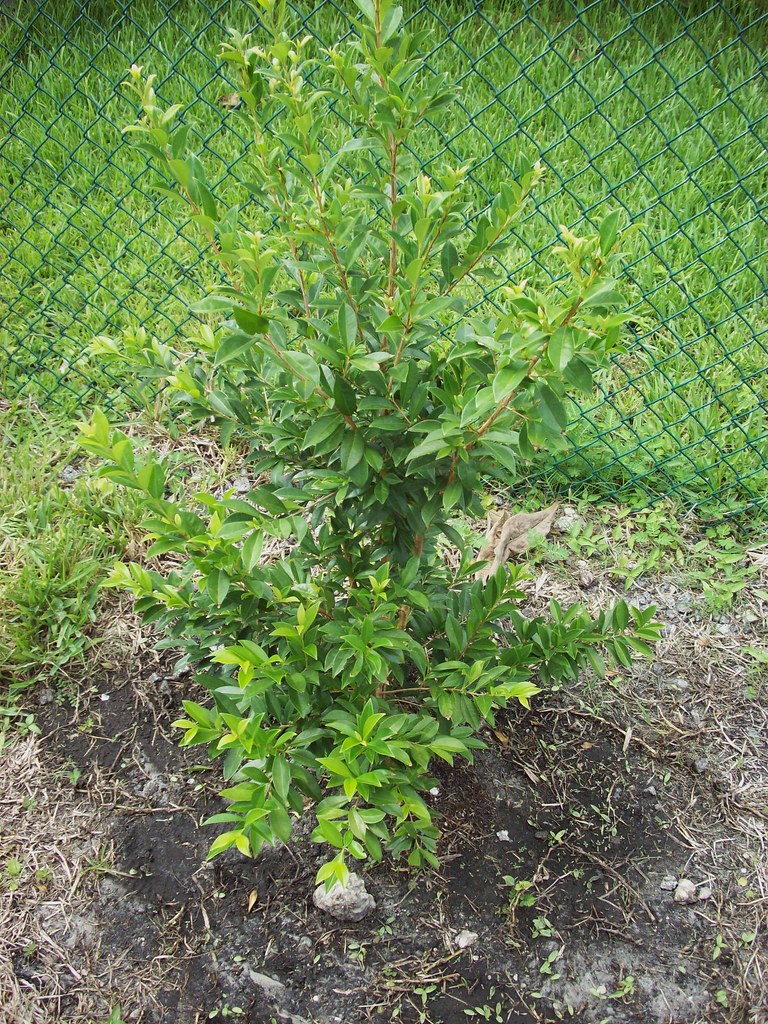
Family: Myrtaceae •
Genus: Eugenia •
Species: aggregata (Kiaersk) •
Country of Origin: Brazil •
Common Names: Cherry of the Rio Grande •
This is the species that is most like a cherry (Prunus spp.) This one I grew from seeds from the RFVC. It is in the ground now and growing fast. I can't wait for fruit. All the following species are native to Brazil. These cherry like fruits are each unique and super tasty.
Eugenia aggregata is a small evergreen tree or large shrub which commonly grows to about 15 feet. However, it may grow as high as 30 feet under favorable conditions. It has an upright, compact habit of growth and is very attractive, especially when in bloom. The smooth, glossy, dark green leaves are narrow elliptic, 2½ to 3 inches long and are borne on short, grooved petioles. The white flowers are solitary and are borne in the axils of opposite bracts from March to May.
The fruit is oblong to obovate, ¾ to 1 inch long, with a persistent calyx at the apex. The skin is thin and dark red or purple in color. The juicy flesh has a good, subacid flavor. It contains none or 1 to 2 white, rounded seeds, about ¼ inch in diameter. The fruit matures in April to June, about 3 weeks after the flowers open. Fruiting may occur in the third year after planting under favorable conditions but it often takes longer.
excerpt from http://edis.ifas.ufl.edu/MG044
Ubaias
 first photo by Lucia Passos
first photo by Lucia Passos
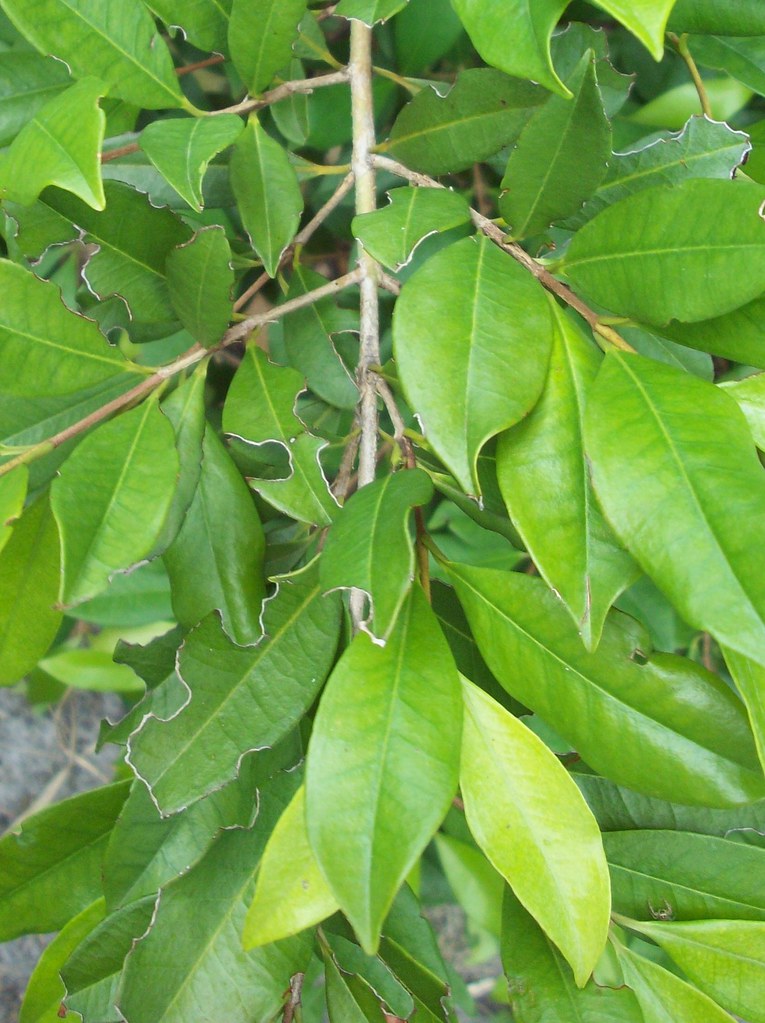
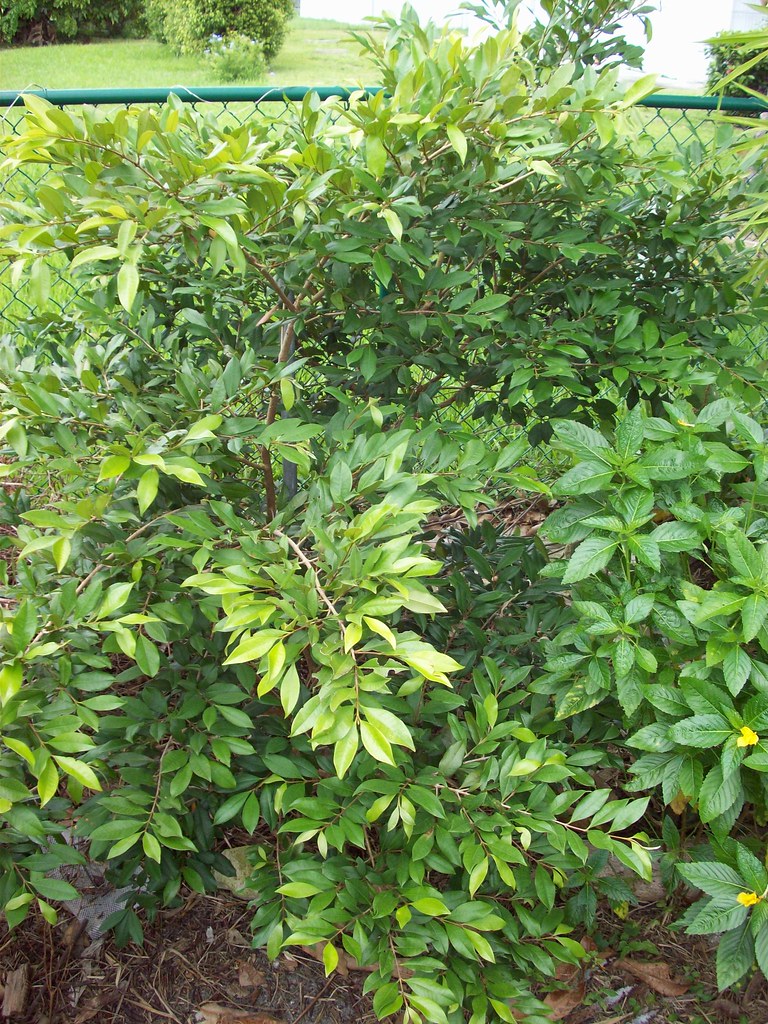
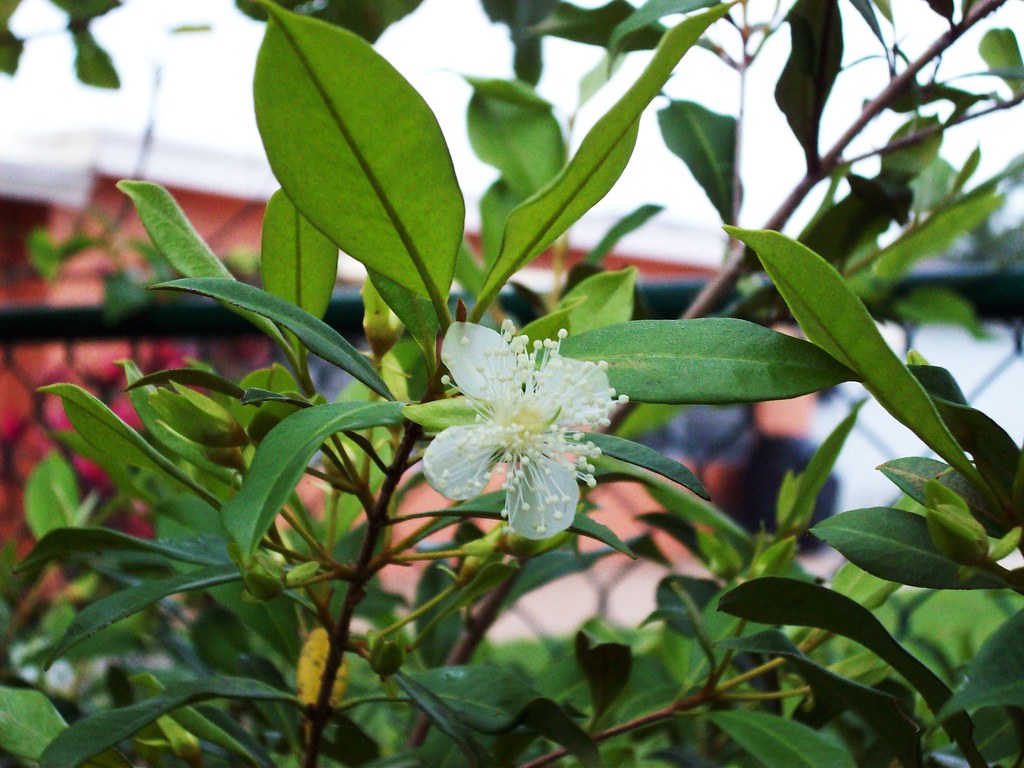
Family: Myrtaceae •
Genus: Eugenia •
Species: luschnathiana (Klotzch) •
Country of Origin: Brazil •
Common Names: Ubaias, Uvalha do Campo, Pitomba (there is some confusion with this name as it's used for
Talisia esculenta as well) •
This is the one I like the best orange fleshed and it tastes sort of like apricots. I bought this plant at a RFVC plant sale. I've had flowers but no fruit yet. It flowered twice so far this year, since I moved it to more sunlight.
Eugenia luschnathiana is a small, spreading evergreen tree or shrub which may attain a height of 25 to 30 feet. The tree has a compact growth habit with dense foliage and is quite attractive, especially when in fruit. The leathery leaves are elliptical lanceolate, about 3 inches long and are a glossy deep green color on the upper surface and light green below. The showy, white flowers, up to 1 inch across, appear from April to June.
The fruit is broadly obovoid, about an inch long, with the apex crowned by 4 or 5 green sepals, about ½ inch long. The thin skin is a bright orange yellow. The soft, melting, juicy flesh is orange in color and aromatic, sweet to sub-acid in flavor. The fruit contains 1 to several seeds attached to one side of the seed cavity. The fruit matures from May to June and sometimes there is a light crop in the fall. The pitomba usually begins fruiting in about the fourth year after planting.
excerpt from http://edis.ifas.ufl.edu/MG044
Grumichama
 first photo from http://www.hawaiifruit.net/12trees.html
first photo from http://www.hawaiifruit.net/12trees.html
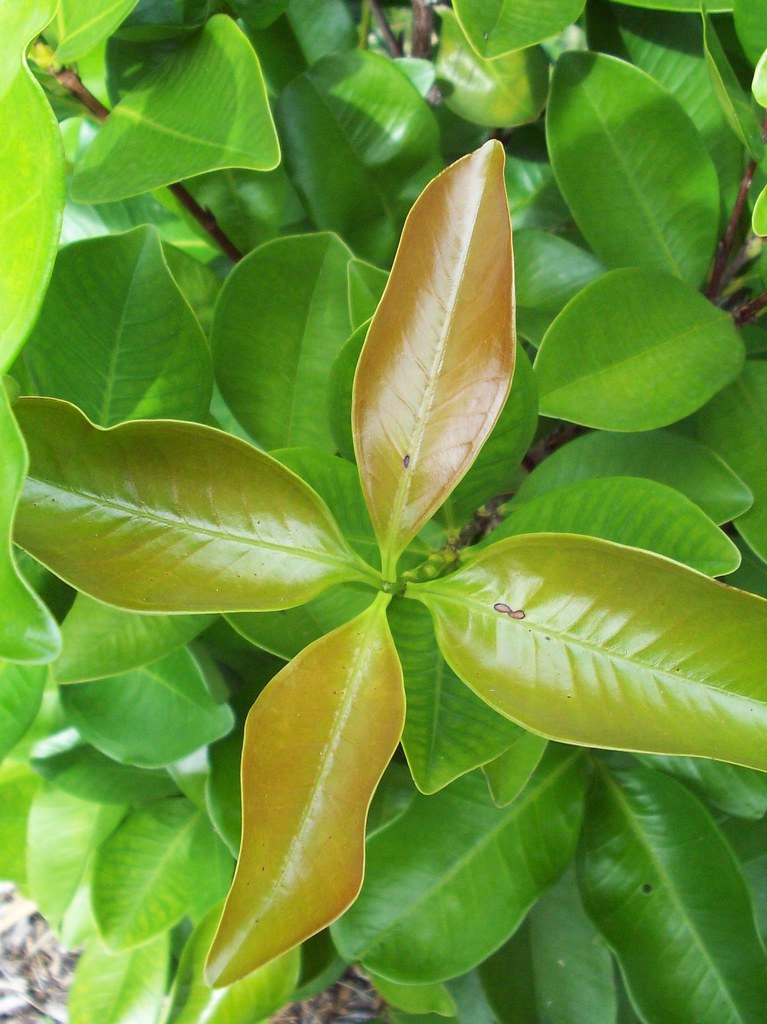
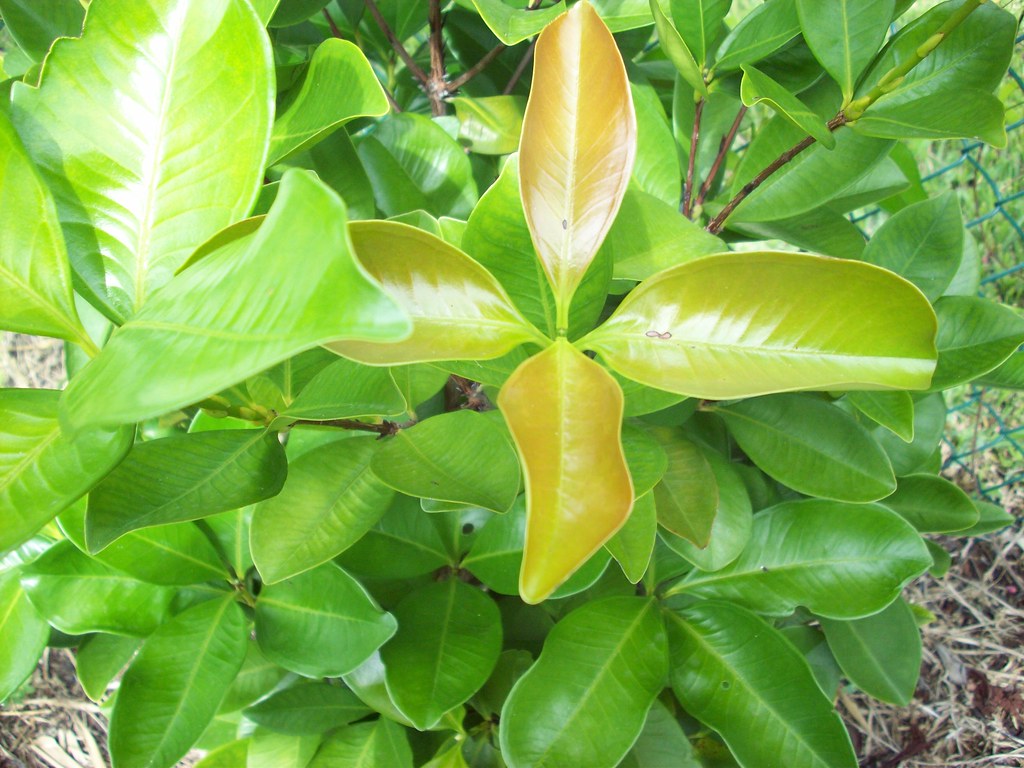
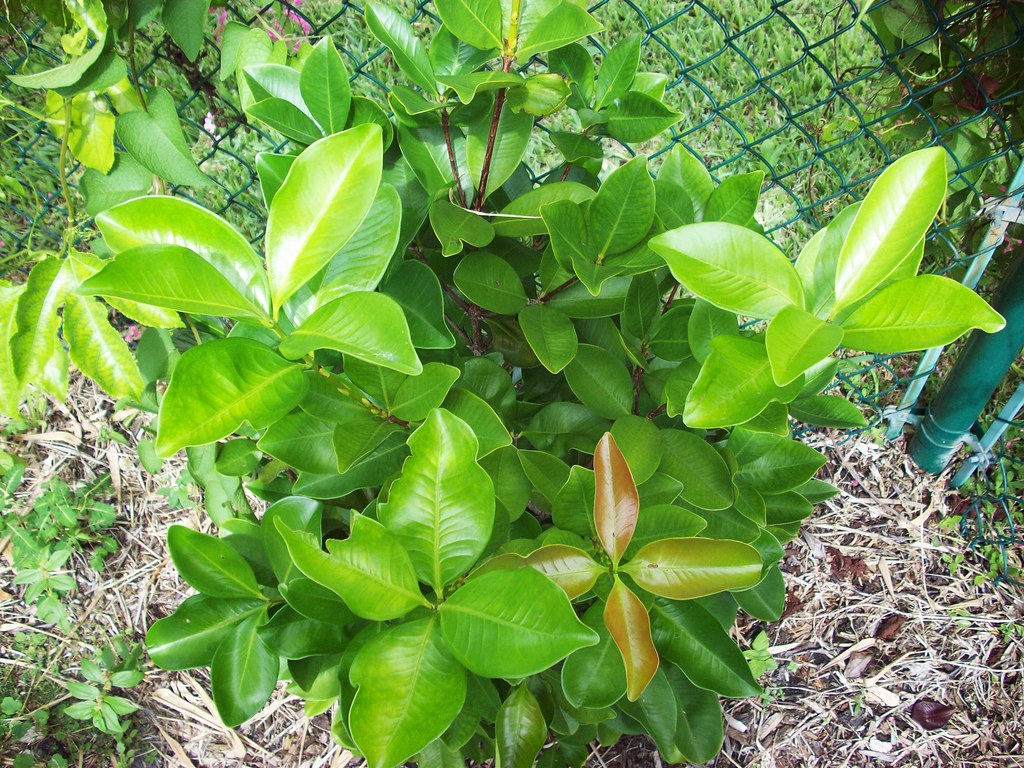
Family: Myrtaceae •
Genus: Eugenia •
Species: brasiliensis (Skeels) •
Country of Origin: Brazil •
Common Names: Grumichama •
This one I grew from seeds from the RFVC. It tastes like a cherry with hints of clove and spices.
They are all flourishing and I expect fruit this year! Everyone who tasted this at the RFVC sale this year bought a plant to take home.
Eugenia brasiliensis is a large evergreen shrub or small tree which may grow to a maximum height of 20 to 25 feet. It is very attractive in appearance with an upright, compact growth habit. The leathery leaves are oval to obovate, about 3 to 4 inches long by 2 inches wide, reddish when young, becoming glossy, deep green. The showy white flowers, up to 1 inch across, are borne in the leaf axils and are produced in large numbers on flushes of new growth in early spring.
The fruit is globose to oblate, ½ to 1 inch in diameter, has persistent green sepals at the apex and is borne on long, slender stems, often in clusters. The thin, delicate skin is scarlet to purplish black. The soft, melting flesh is sweet with an excellent flavor. The seeds are round, hemispherical, or angular, depending on the number present. The fruit matures in April to May, about a month after flowering. It takes 2 to 3 years to bear fruit from seed.
excerpt from http://edis.ifas.ufl.edu/MG044
I grow Surinam Cherry - E. uniflora as well but figured it to common to include.
I'm also germinating Pera do Campo - Eugenia klotzschiana, Pitangatuba - Eugenia neonitida and Araça-boi - Eugenia stipitata I'll add them to this post when I have them grown out!!
updated 05-31-2009

Eugenia spp. by Eric Bronson is licensed under a Creative Commons Attribution-Noncommercial-No Derivative Works 3.0 United States License.
Based on a work at www.flickr.com
Monday, May 31, 2010
Eugenia spp.
Posted by Eric Bronson at 7:00 AM 3 comments
Labels: myrtaceae, tropical fruits, University of Florida
Friday, May 7, 2010
Jacaranda jasminoides

Family: Bignoniaceae •
Genus: Jacaranda •
Species: jasminoides •
Country of Origin: Central to South America •
Synonyms: Jacaranda pubescens •
Common Names: Maroon Jacaranda, Caroba-Brava •
This is a small tree that can ultimately reach twenty three to twenty-five feet high with a slightly wider diameter. It has fine-textured, fern-like pinnate leaves that are typical of the Jacaranda genus. Flowers are borne on apical panicles and are a deep purple color. The tree covers itself with the showy trumpet shaped flowers and puts on quite a breathtaking floral display. Its deep purple clusters of trumpet shaped blossoms appear in the spring, later falling to the earth carpeting the ground with a mass of color. It is said that if you are walking underneath the Jacaranda tree and one of the trumpet blossoms falls on your head you will be favored by fortune. Margaret Barwick describes this tree in her book Tropical and Subtropical Trees as being precocious and she is absolutely right. I planted this small seedling in 2008 in honor of my Mothers birthday. I was delighted to see it was blooming just in time for her birthday this year and she was tickled pink. I am hoping that it will bloom every year at this time what an amazing bonus that blooming coincides with her birthday and Mothers Day each year!
Sources:
Barwick, M. (2004). Tropical & subtropical trees. Portland, OR: Timber Press.
Cirnaru, C. (2010). Jacaranda jasminoides. Retrieved from http://www.ntbg.org/plants /plant_details.php?plantid=6618

Jacaranda Jasminoides by Eric Bronson is licensed under a Creative Commons Attribution-Noncommercial-No Derivative Works 3.0 United States License.
Based on a work at www.flickr.com
Posted by Eric Bronson at 3:18 PM 5 comments
Labels: bignoniaceae, trees
Thursday, May 6, 2010
Annona muricata Soursop

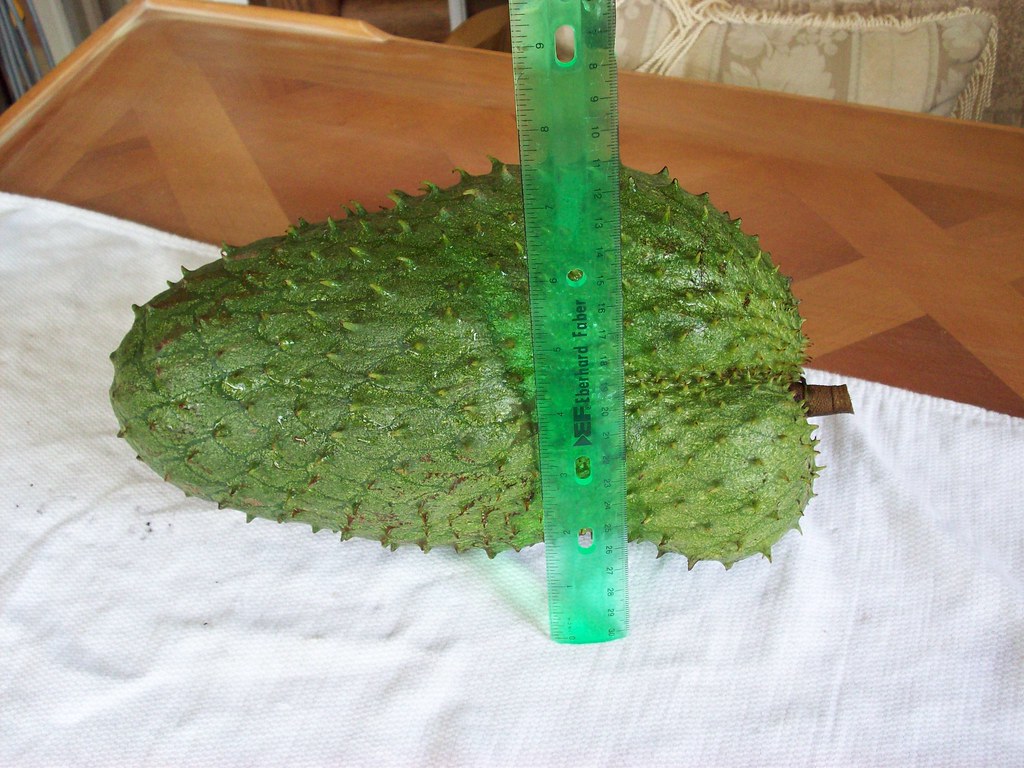
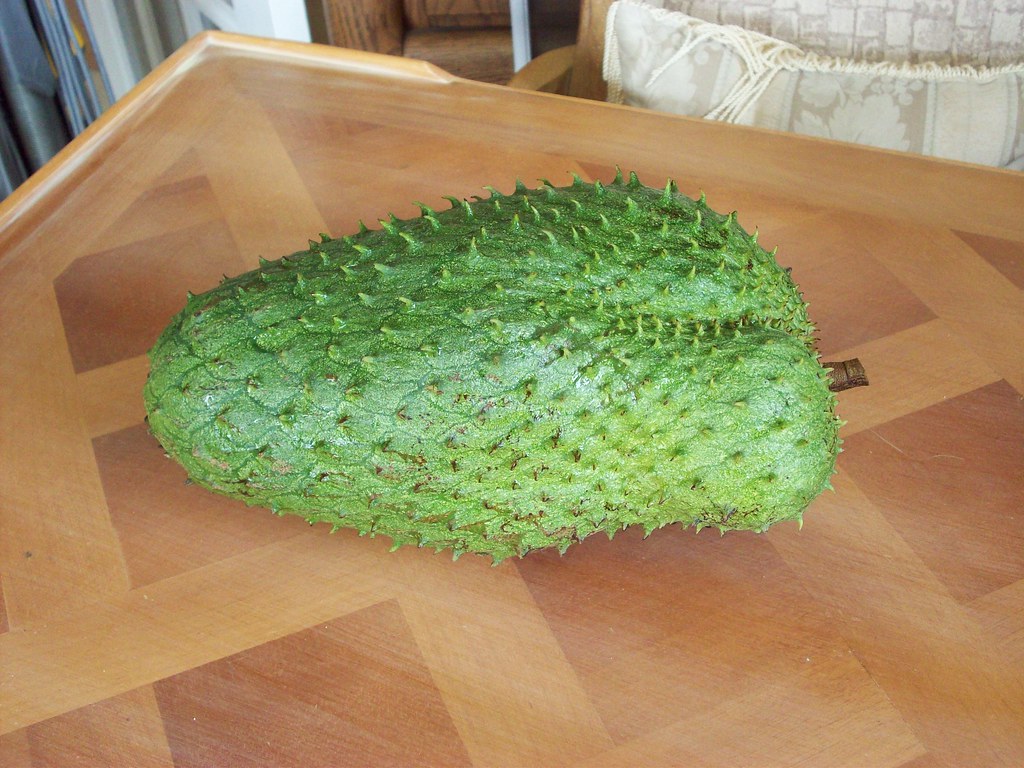 06-30-2009: It's turning slightly yellow so it's harvest time. It will be ready to eat in a day or two. Yummy, I can't wait to eat it and it is just in time for my birthday(what a great present from nature) and the fourth of July!! Pictures of the inside coming soon!!!
06-30-2009: It's turning slightly yellow so it's harvest time. It will be ready to eat in a day or two. Yummy, I can't wait to eat it and it is just in time for my birthday(what a great present from nature) and the fourth of July!! Pictures of the inside coming soon!!!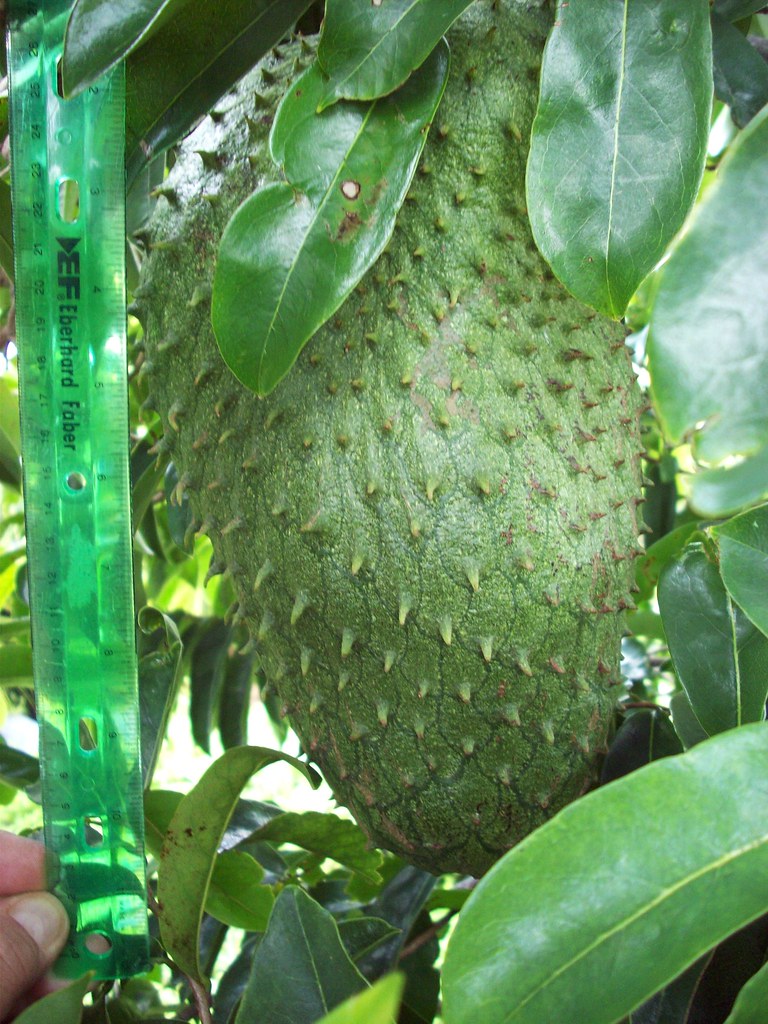 06-28-2009: Almost time! Growing Soursop fruit (all photos are of my tree )
06-28-2009: Almost time! Growing Soursop fruit (all photos are of my tree ) 06-16-2009: It's getting bigger!!!
06-16-2009: It's getting bigger!!! 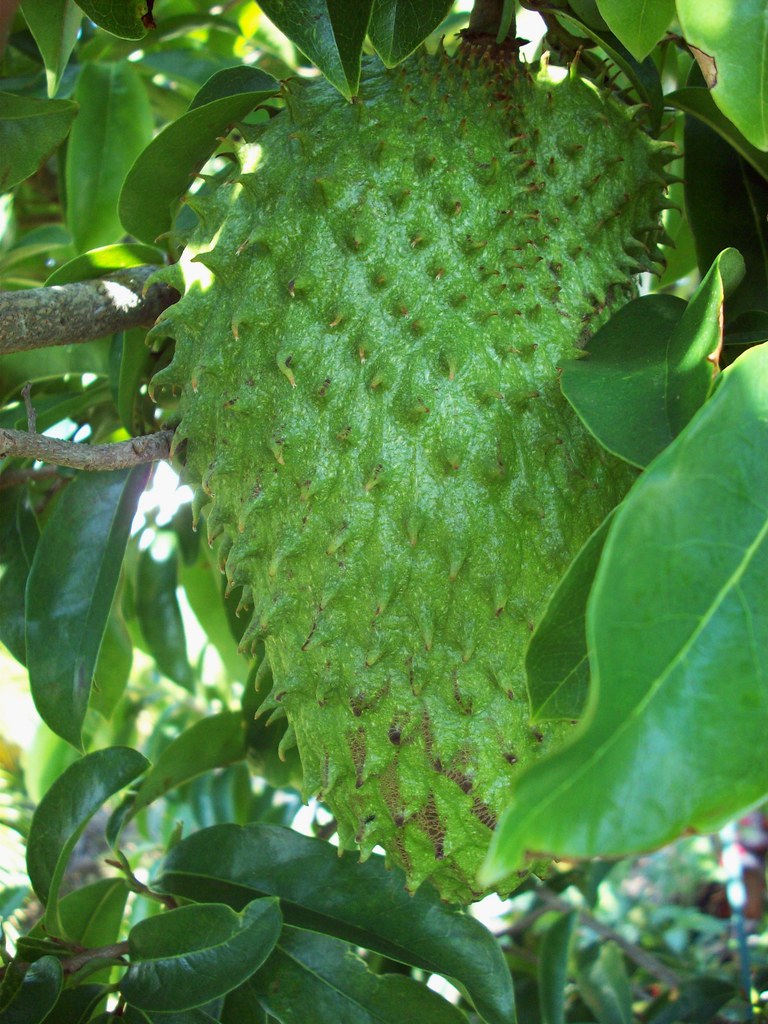 05-09-2009: Immature fruit growing fast!
05-09-2009: Immature fruit growing fast! 05-09-2009: Well camouflaged immature fruit.
05-09-2009: Well camouflaged immature fruit. Family: Annonaceae •
Genus: Annona •
Species: Muricata (L.) •
Country of Origin: South America •
Common Names: Guanábana, Soursop •
This fruit is popular in Jamaica, the Caribbean and South America where the fruit is eaten raw, made into ice cream or a favorite of many, a smoothie made with the pulp, sweetened condensed milk and ice! This is a relative to the Sugar Apple and the Cherimoya. I've only had one fruit make it to the table so far but it will get more fruitful as it gets older. Update 06-16-2009: My tree is doing amazing this year, I have another fruit on the way and the tree is flowering like crazy!!
Soursop is a small tree, usually slender in habit and rarely more than 20 feet high. Mine is about 15 feet high and ten feet in diameter. The leaves are obovate to elliptic in form, commonly 3 to 6 inches long, acute, leathery in texture, glossy above and glabrous beneath. Deeply green with proper nutrition.
The flowers are large, the three exterior petals ovate-acute, valvate, and fleshy, the interior ones smaller and thinner, rounded, with the edges overlapping, are creme-yellow outside and light yellow inside and lightly fragrant.
The fruit is the largest of the Annonas; specimens 5 pounds in weight are not uncommon and much larger ones have been reported. More typically though in South Florida, about twelve inches long and six to eight inches in diameter. It is ovoid, heart-shaped, or oblong-conical in form, deep green in color, with numerous short fleshy spines on the surface. It starts to turn yellowish-green upon ripening. The skin has a rank, bitter flavor. The flesh is white, somewhat cottony in texture, juicy, and highly aromatic. Numerous brown seeds, much like those of the Cherimoya, are embedded in it. The flavor suggests that of the pineapple and the mango. Although it is totally unique in itself.
Alphonse DeCandolle says that the Soursop "is wild in the West Indies; at least its existence has been proved in the islands of Cuba, Santo Domingo, Jamaica, and several of the smaller islands."Safford states that it is of tropical American origin. The historian Gonzalo Hernandez de Oviedo, in his "Natural History of the Indies," written in 1526, describes the Soursop at some length, and he mentions having seen it growing abundantly in the West Indies as well as on the mainland of South America. At the present day it is perhaps more popular in Cuba than in any other part of the tropics. In Mexico it occurs in many places, and the fruit is often seen in the markets. It is also grown in the tropical portions of South America. This is a tropical tree. It is difficult to grow in South Florida but not impossible. If you find a nice sheltered location, give it lots of water, and organic fertilizer from time to time you should have success. excerpts taken from Manual Of Tropical And Subtropical Fruits by Wilson Popenoe
10-01-2008: Three pictures of my tree with a mineral deficiency that is quite obvious and since rectified with organic fertilizer, look at the leaves in the first photo!
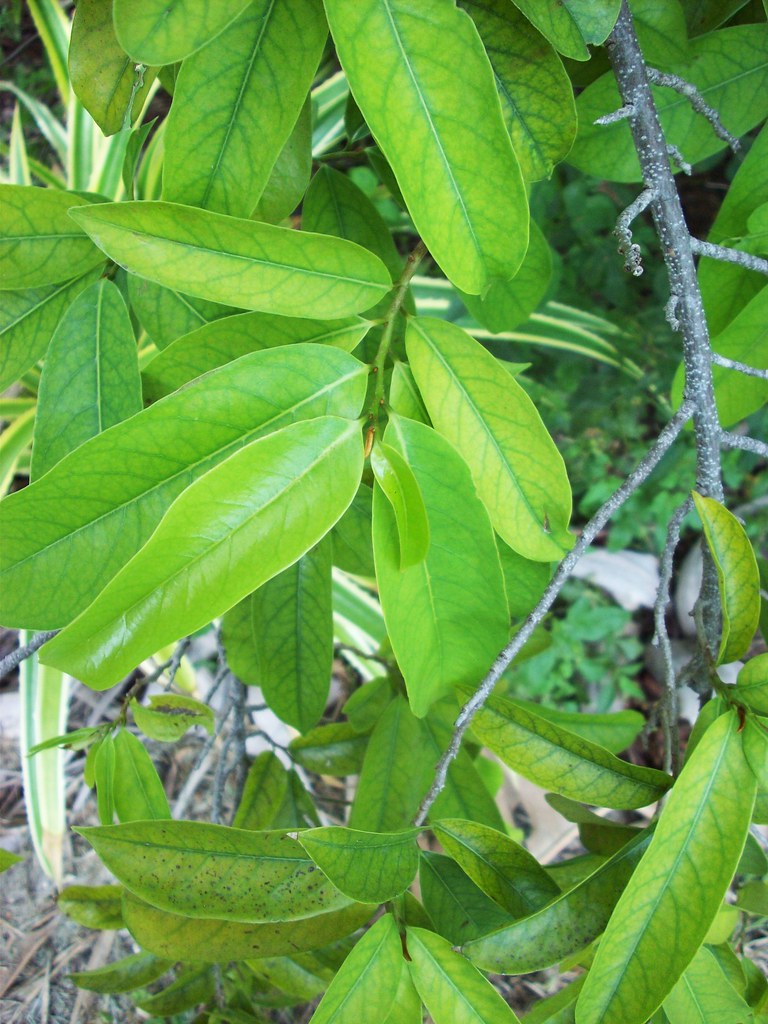
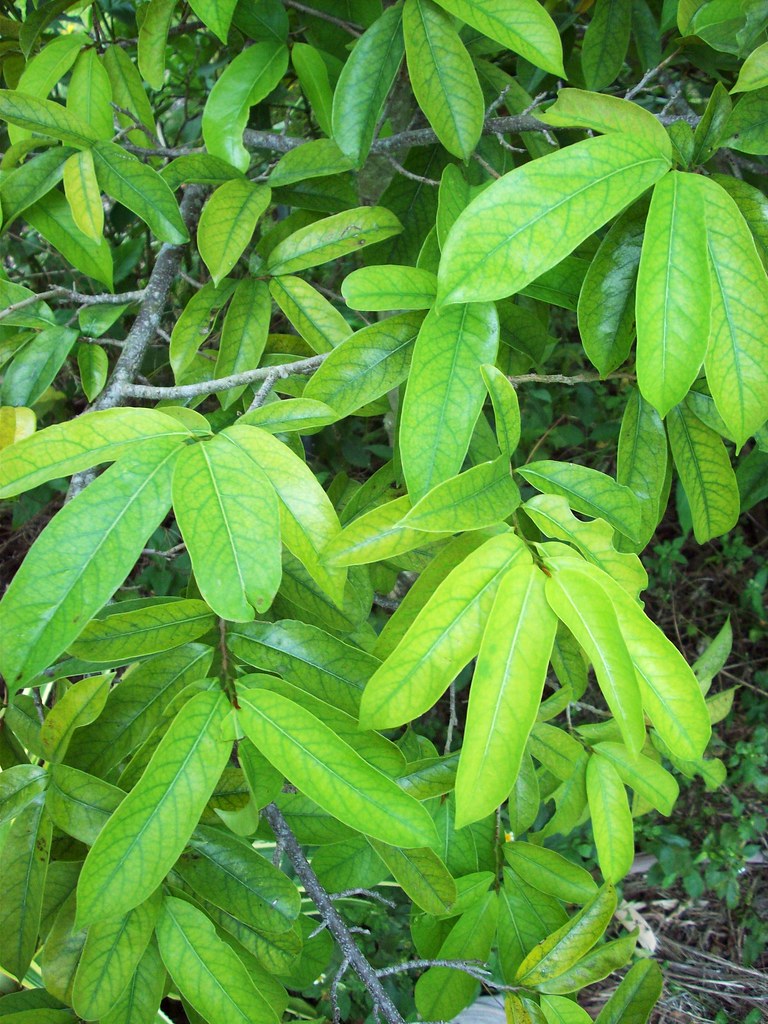
 12-18-2008: Some smaller flower buds
12-18-2008: Some smaller flower buds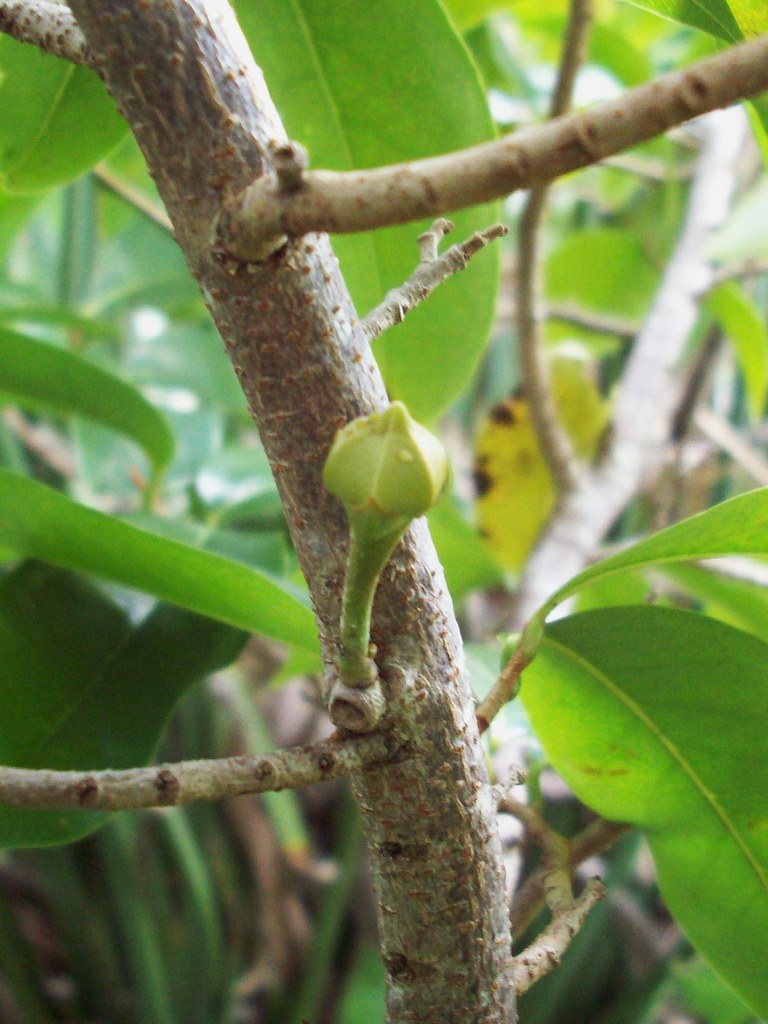
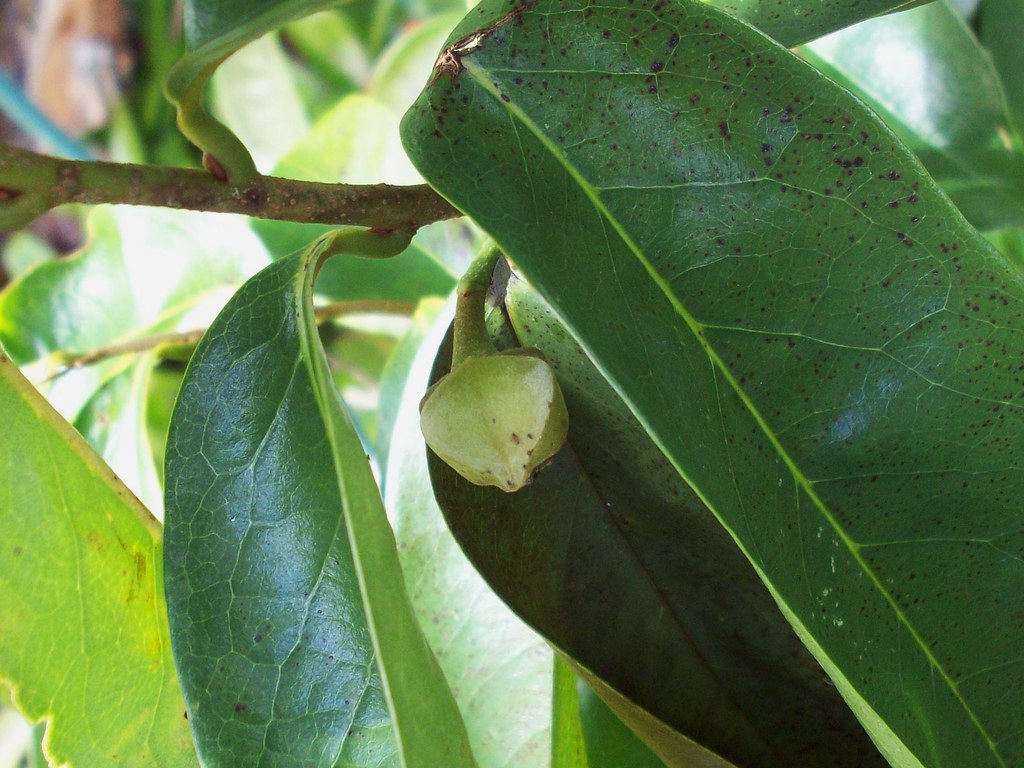 12-18-2008: Flowers, unusual, beautiful and lightly fragrant
12-18-2008: Flowers, unusual, beautiful and lightly fragrant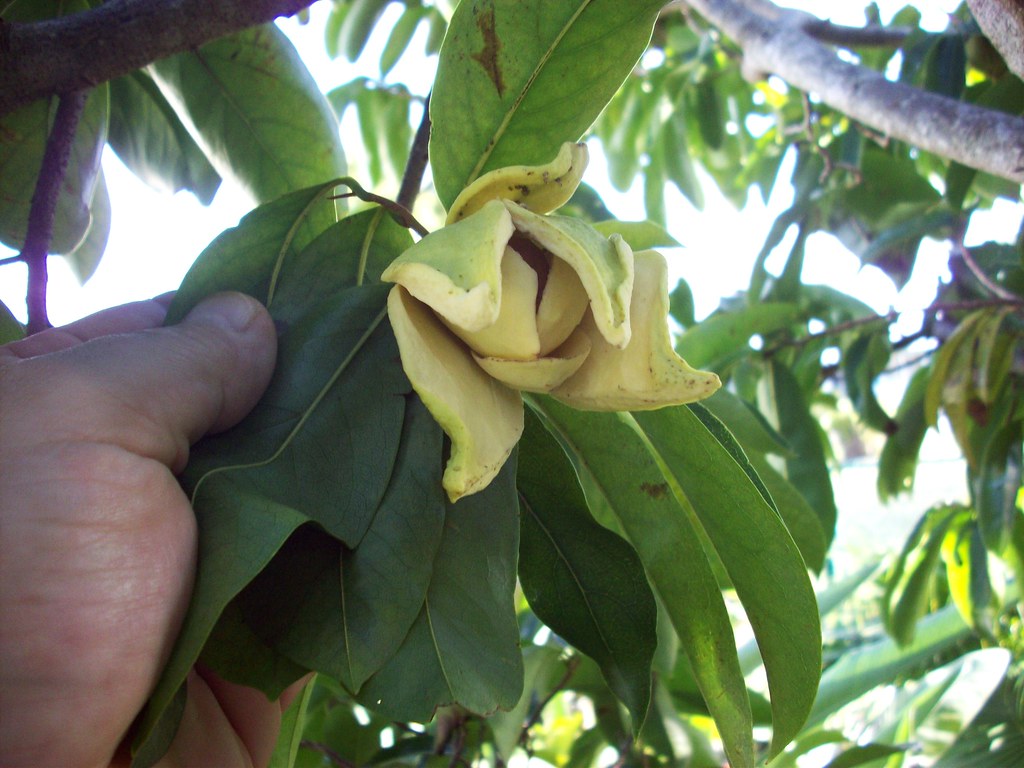

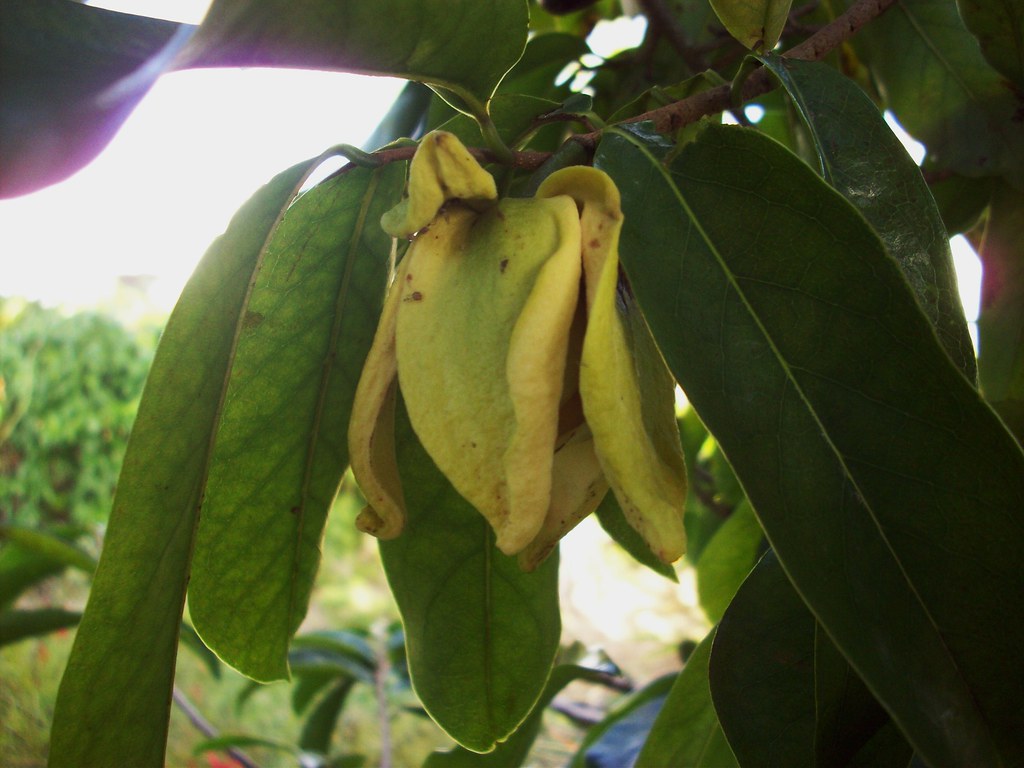 04-19-2009 Immature Fruit
04-19-2009 Immature Fruit
 06-16-2009: See above for new pictures of this fruit
06-16-2009: See above for new pictures of this fruit
Annona muricata Soursop by Eric Bronson is licensed under a Creative Commons Attribution-Noncommercial-No Derivative Works 3.0 United States License.
Based on a work at www.flickr.com
Posted by Eric Bronson at 8:30 AM 2 comments
Labels: annonaceae, tropical fruits
Subscribe to:
Posts (Atom)


